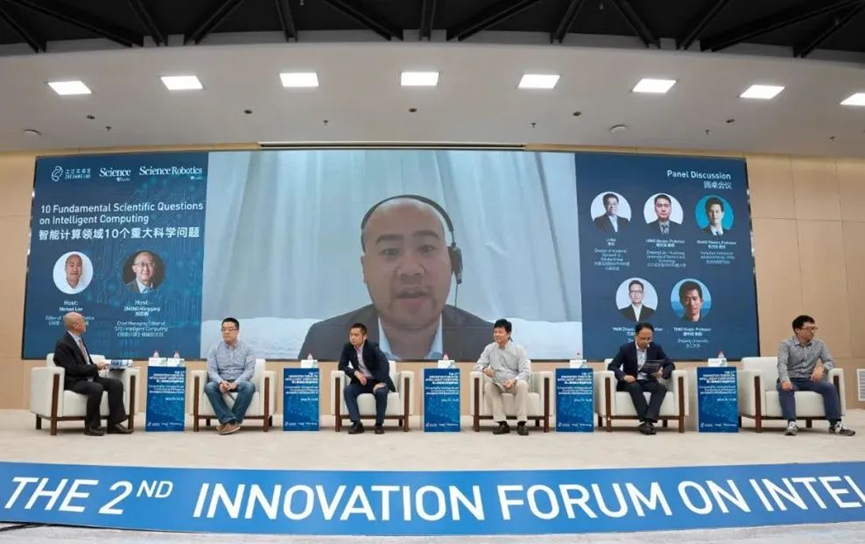


How is the intelligent computing system model constructed?
What are the latest research results in neuromorphic computing?
What is the recent progress in memristor-based CIM technology?
Do autonomous drones fly better than human pilots?
How can photonic computing address the challenges towards general-purpose computing?
What are the advantages and key challenges of novel ferroelectric materials and devices that can be used for intelligent computing?
From October 19 to 20, 2022, Zhejiang Lab and Science/AAAS jointly held the 2nd Innovation Forum on Intelligent Computing. Experts and scholars from well-known universities, research institutes and enterprises at home and abroad gave masterly speeches on the theme of "Computing for Intelligence and Computing by Intelligence", and held panel discussion around 10 fundamental scientific questions on intelligent computing, presenting the research progress in new computing theory, architecture and frontier computing technology in an all-round way.
At the first keynote talk, PAN Aimin, Chief Architect of intelligent computing data reactor of ZJ Lab, presented an intelligent computing system model.
It consists of task, algorithm, computational power, data and knowledge. For any scenarios of intelligent computing, the system model forms a closed loop, which means that the system model can consistently be running, and be optimized with more data and knowledge. PAN Aimin further introduced ZJ Lab's latest practices in intelligent computing. At present, ZJ Lab has developed a computational power aggregation and task scheduling platform - "ZJ Alkiad" intelligent computing operating system. The system can provide corresponding algorithms, functions or frameworks for different computing tasks, and is able to aggregate computational power and marshal data, so as to make data reach compute clusters and nodes efficiently, realize the efficient use of large-scale computational power, and support computing needs in all fields.
During the two-day forum, a number of experts shared their research on new computing technologies.
Mike Davies, Director of Intel's Neuromorphic Computing Lab, shared the latest research advances on Intel's Loihi 2 chip and the Lava software framework.
The goal of neuromorphic computing is to bridge the orders-of-magnitude gap in efficiency, adaptability, and speed between biological brains and today's computing technology. The past several years have seen significant progress in neuromorphic computing research, with chips like Intel's Loihi demonstrating, for the first time, remarkable results from sensory perception to data efficient learning and then to combinatorial optimization.
FANG Lu, Associate Professor of Department of Electronic Engineering at Tsinghua University, shared the research results in photonic computing.
Endowed with the merits of high-speed and low-loss propagation, light has shown great potential to revolutionize the next-generation computing technology. However, photonic computing confronts with various challenges towards ubiquitous and general computing, such as the lack of reconfigurability, learning capability, computing scalability, etc. To address these challenges, FANG Lu introduced a large-scale reconfigurable diffractive processing unit (DPU) containing millions of parameters, which can be used to construct various architectures of optical neural network (ONN) with orders of magnitude increase in the computing efficiency.
Can we make autonomous drones fly better than human pilots? Davide Scaramuzza, a Professor of Robotics and Perception at the University of Zurich, raised this question in his speech.
Autonomous drones play a crucial role in search-and-rescue, delivery, and inspection missions. However, they are still far from human pilots regarding speed, versatility, and robustness. Davide Scaramuzza showed how the combination of model-based and machine learning methods with new low-latency sensors can allow drones to achieve unprecedented speed and robustness by relying solely on onboard computing.
Marco Dorigo, Professor at Université Libre de Bruxelles and founder of the ant colony optimization algorithm, also talked about intelligent robots.
Marco Dorigo presented a novel robot swarm architecture for self-organized hierarchy in the talk, and showed the latest results of experiments in which the architecture combining the advantageous features of self-organized and centralized control can split and merge independently controlled sub-swarms, replace faulty robots at any point in the hierarchical network, and dynamically modify the collective behavior of the swarm on the fly.
Masashi Sugiyama, Professor at the University of Tokyo; WU Huaqiang, Dean of School of Integrated Circuits at Tsinghua University; Schahram Dustdar, Professor of Computer Science at the TU Wien; Michael Wooldridge, Head of Department of Computer Science at the University of Oxford; CHEN Haibo, Distinguished Professor at Shanghai Jiao Tong University; LI Di, Chief Scientist of FAST of National Astronomical Observatories; HAN Yinhe, Professor at Institute of Computing Technology, Chinese Academy of Sciences; HAN Genquan, Professor at Xidian University; and Guido de Croon, Professor at Delft University of Technology, respectively delivered wonderful speeches on their research fields.
At the forum, ZJ Lab and Science/AAAS jointly released 10 fundamental scientific questions on intelligent computing (read more). WAN Zhiguo, Executive Director of Research Center for Basic Theories of Intelligent Computing of ZJ Lab; ZHANG Weimin, Visiting Scholar of Hangzhou Institute for Advanced Study, UCAS and Distinguished Professor of Department of Physics at Cheng Kung University; LI Bei, Director of Aliyun University Cooperation Program (AUCP) and Science & Technology Public Welfare Program; JIANG Wenbin, Senior Research Expert of ZJ Lab and Professor at Huazhong University of Science and Technology; TANG Huajin, Professor at Zhejiang University; Michael Lee, Editor of Science Robotics; and ZHANG Honggang, Chief Managing Editor of Intelligent Computing, further discussed the 10 fundamental questions in the panel meeting.

"The release of the 10 Fundamental Scientific Questions is a big deal for the world of intelligent computing and even the scientific community. I hope this forum could answer your questions and raise more new ones. I also look forward to the transformation of intelligent computing from theoretical research to practical application in the future, and more achievements." Michael Lee said.
ZJ Lab and Science/AAAS have jointly held the Innovation Forum on Intelligent Computing for the second consecutive year, which attracted 18,000 online participants. ZHAO Xinlong, Vice President of ZJ Lab, said that the two-day forum fully showed that intelligent computing has become the focus of attention of global experts and scholars in the fields of advanced computing and software, and is an underlying technology that promotes digital civilization. In the future, ZJ Lab, together with global experts and scholars, will continue to promote the development of intelligent computing technology, iterate and publish major scientific questions on intelligent computing, and build the Innovation Forum on Intelligent Computing into an open platform for international academic exchanges.

PAN Yunhe, Academician of Chinese Academy of Engineering and Chief Scientist in Artificial Intelligence at ZJ Lab, said that "in the field of computer science, the intelligent computing system is taking shape and beginning to develop both in scope and in depth. I believe that creating an intelligent computing innovation ecosystem through continuous and in-depth international cooperation and exchanges will accelerate intelligent computing applications in scientific research, industrial development, social governance and other fields".














